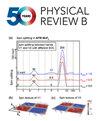钛酸铅铁电相变中的热无序和声子软化
IF 3.7
2区 物理与天体物理
Q1 Physics and Astronomy
引用次数: 0
摘要
本文报道了PbTiO3晶体铁电相变质量的分子动力学研究。我们使用现代机器学习技术,根据密度泛函理论数据训练的势能和极化曲面,准确地模拟了非调和性。我们的模拟表明,相变具有很强的有序-无序特征,与衍射实验一致,并为跨相变平衡的方法提供了新的见解。我们发现宏观极化的出现和消失是由纳米尺度上的偶极开关驱动的。我们还计算了铁电相和准电相的红外光谱,发现与实验拉曼频率吻合得很好。通常,用拉曼散射检测到的准电相软模几乎理想的位移特性与衍射实验表明的有序-无序跃迁特性进行了对比。我们通过证明软模与与偶极子热无序相关的强德拜弛豫共存来解决这个问题。德拜弛豫特征以零频率为中心,出现在铁电相和准电相的转变温度附近。2025年由美国物理学会出版本文章由计算机程序翻译,如有差异,请以英文原文为准。
Thermal disorder and phonon softening in the ferroelectric phase transition of lead titanate
We report a molecular dynamics study of quality of the ferroelectric phase transition in crystalline PbTiO3. We model anharmonicity accurately in terms of potential energy and polarization surfaces trained on density functional theory data with modern machine learning techniques. Our simulations demonstrate that the transition has a strong order-disorder character, in agreement with diffraction experiments, and provide fresh insight into the approach to equilibrium across the phase transition. We find that the emergence and disappearance of the macroscopic polarization is driven by dipolar switching at the nanometer scale. We also computed the infrared optical absorption spectra in both the ferroelectric and the paraelectric phases, finding good agreement with the experimental Raman frequencies. Often, the almost ideal displacive character of the soft mode detected by Raman scattering in the paraelectric phase has been contrasted with the order-disorder character of the transition suggested by diffraction experiments. We settle this issue by showing that the soft mode coexists with a strong Debye relaxation associated with thermal disordering of the dipoles. The Debye relaxation feature is centered at zero frequency and appears near the transition temperature in both the ferroelectric and the paraelectric phases. Published by the American Physical Society 2025
求助全文
通过发布文献求助,成功后即可免费获取论文全文。
去求助
来源期刊

Physical Review B
物理-物理:凝聚态物理
CiteScore
6.70
自引率
32.40%
发文量
0
审稿时长
3.0 months
期刊介绍:
Physical Review B (PRB) is the world’s largest dedicated physics journal, publishing approximately 100 new, high-quality papers each week. The most highly cited journal in condensed matter physics, PRB provides outstanding depth and breadth of coverage, combined with unrivaled context and background for ongoing research by scientists worldwide.
PRB covers the full range of condensed matter, materials physics, and related subfields, including:
-Structure and phase transitions
-Ferroelectrics and multiferroics
-Disordered systems and alloys
-Magnetism
-Superconductivity
-Electronic structure, photonics, and metamaterials
-Semiconductors and mesoscopic systems
-Surfaces, nanoscience, and two-dimensional materials
-Topological states of matter
 求助内容:
求助内容: 应助结果提醒方式:
应助结果提醒方式:


